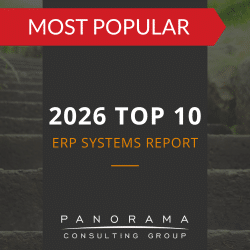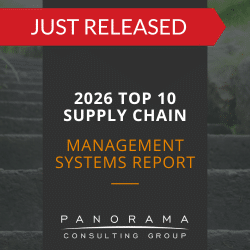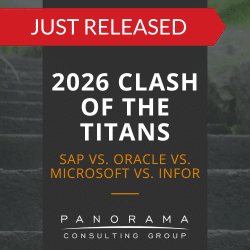Enterprise resource planning (ERP) systems have evolved from mere tools for automating processes to strategic assets that drive growth, innovation, and competitiveness. In the fast-paced business landscape of the information age, having an enterprise resource planning strategy is crucial for organizations seeking to adopt modern technology.
Today, we’re sharing expert advice for developing an effective ERP strategy.
Understanding Enterprise Resource Planning Systems
The Evolution of ERP Systems
ERP systems have undergone significant changes since their inception. Initially designed to streamline manufacturing processes, ERP systems have expanded to cover a wide range of industries and business functions.
For example, a supply chain management system is a type of enterprise software that manages the flow of goods and services from production to distribution.
Modern ERP solutions leverage advanced technologies, like artificial intelligence (AI) and machine learning (ML), to offer enhanced functionality, adaptability, and scalability. Today’s ERP systems are characterized by their ability to provide real-time insights that drive strategic decision-making.
The Importance of ERP Systems
In the information age, ERP systems play a pivotal role in aggregating data, analyzing trends, and making predictions. This enables organizations to respond swiftly to market changes and emerging opportunities.
At the same time, ERP solutions streamline workflows and automate repetitive tasks to improve operational efficiency
Another key function of ERP systems is helping organizations adhere to regulatory requirements and mitigate risks. These systems use compliance management functionality to maintain accurate records, and they have robust security features for protecting sensitive data and ensuring that access controls align with regulatory standards.
The 2026 Top 10 ERP Systems Report
What vendors are you considering for your ERP implementation? This list is a helpful starting point.
What is the “Information Age”?
The information age refers to the rapid shift from traditional industry to an economy based on information technology. In this era, data is a crucial asset, and the ability to harness and analyze data is key to gaining a competitive advantage.
Companies are increasingly relying on data analytics, AI, and cloud computing to make informed decisions. In this context, ERP systems serve as the backbone of digital transformation, enabling organizations to integrate disparate data sources and gain insights that support strategic objectives.
Crafting an Effective Enterprise Resource Planning Strategy: 5 Best Practices
1. Setting Clear Objectives and Goals
The foundation of a successful enterprise resource planning strategy is a clear understanding of your long-term organizational goals.
Defining measurable key performance indicators (KPIs) related to these goals is crucial for evaluating the success of your ERP implementation. Performance metrics provide a benchmark for assessing the system’s impact on business outcomes.
2. Understanding Your Needs
Before embarking on an ERP implementation, you must understand your current pain points and process inefficiencies.
Our ERP selection consultants often help clients map their business processes to analyze existing operations and identify gaps and opportunities for optimization. This, along with software requirements gathering, helps us create a list of vendors that could fit the organization’s needs.
During this time, it’s also important to assess your current IT infrastructure to determine compatibility with your new ERP system and identify any necessary upgrades or data storage enhancements.
3. Choosing the Right Implementation Approach
There are two main implementation approaches to consider. You can also use a hybrid approach that combines these two strategies.
Phased Implementation Approach
A phased implementation approach involves rolling out the ERP system in stages.
This approach provides several benefits:
- Risk mitigation – By implementing the system incrementally, organizations can identify and address potential issues early, reducing the likelihood of major disruptions. This approach allows for iterative testing and refinement, minimizing the impact of unexpected challenges.
- Easier change management – Implementing changes gradually gives employees more time to adapt to new processes and technology. However, training should still be comprehensive and communication should still be frequent.
- Continuous improvement opportunities – With a phased approach, organizations can leverage lessons learned from each stage to make informed adjustments. This facilitates ongoing optimization, enhancing both system functionality and user experience.
Big Bang Implementation Approach
The big bang approach involves implementing the entire ERP system across the organization at once.
While this approach can mean faster deployment, it also carries higher risks. Comprehensive planning is crucial to ensure a smooth transition and minimize disruptions.
For instance, during the planning phase, an organization might allocate specific personnel to critical tasks, such as data migration and user training. This would ensure a clear focus on ensuring a seamless implementation.
In addition, the organization might develop a contingency plan to address potential challenges, such as system downtime and user resistance.
4. Determining Your Integration Strategy
Organizations typically have multiple applications and systems throughout their business. When a new ERP system comes along, it won’t necessarily replace the functionality of all these systems, but it will need to integrate with them.
Here are some considerations for your enterprise resource planning integration strategy:
Data Integration and Management
Data must flow seamlessly between the ERP system and other applications to enable real-time insights and informed decision-making.
We recommend ensuring data accuracy, consistency, and completeness by cleansing and standardizing your data before migrating it to a new system.
In addition, it’s important to establish data governance to define who has access to specific data, how data is stored and protected, and how data quality is maintained.
Application Integration
Application integration ensures seamless collaboration and communication across departments.
Many organizations use APIs and middleware solutions to connect disparate systems and ensure interoperability. Sometimes, especially with legacy systems, it becomes necessary to develop custom integration solutions to address unique business requirements and enhance system functionality.
5. Anticipating ERP Implementation Challenges
Before developing an enterprise resource planning implementation strategy, you must know what to expect in terms of implementation challenges. These include but aren’t limited to:
Budget Constraints and Resource Allocation
ERP implementations can be costly and resource-intensive, making budget constraints a common challenge. To manage costs effectively, you should set realistic expectations by considering both direct and indirect costs.
In addition, allocating sufficient resources is essential as the required internal resource commitment can be higher than organizations expect.
User Adoption
Low user adoption has derailed many ERP projects. To circumvent this challenge, it’s important to engage stakeholders early in the implementation process. You can engage stakeholders in the following ways:
- Involving employees from various functional areas in requirements gathering sessions
- Providing comprehensive training programs
- Clearly communicating the benefits of the ERP system and the expected changes to workflows and responsibilities
These are just three change management strategies to employ during an ERP implementation. Organizational change management (OCM) actually involves much more than communication and training. (Learn more by reading our blog post, What is Effective Change Management?)
Technical Challenges and System Integration
Technical challenges, such as system integration and compatibility issues, can hinder ERP implementation success. To address these challenges, you should engage an experienced ERP consultant for project oversight throughout the implementation process.
Developing contingency plans to address potential technical challenges and ensure a smooth transition is also important.
Low Benefits Realization
While many organizations expect to realize benefits within months of go-live, this is an unrealistic expectation. Most business benefits take a year or more to fully realize.
That’s why post-implementation is one of the most important phases of your ERP project. We recommend using this time to monitor business performance, gather user feedback, and iteratively make improvements.
Building a Future-Ready ERP Strategy
By aligning ERP initiatives with business objectives and anticipating potential implementation challenges, organizations can thrive in the information age.
Our business software consultants can help you plan for a successful ERP selection and implementation. Contact us below for a free consultation.













